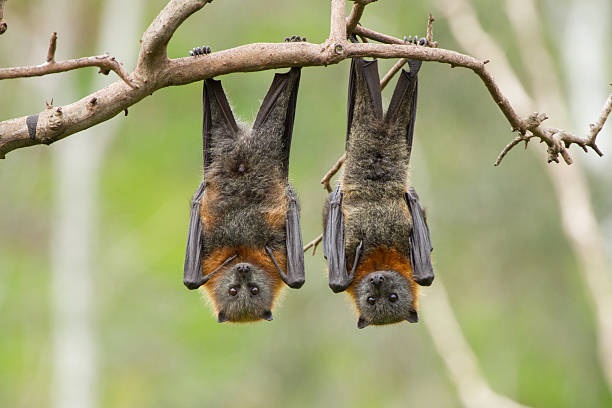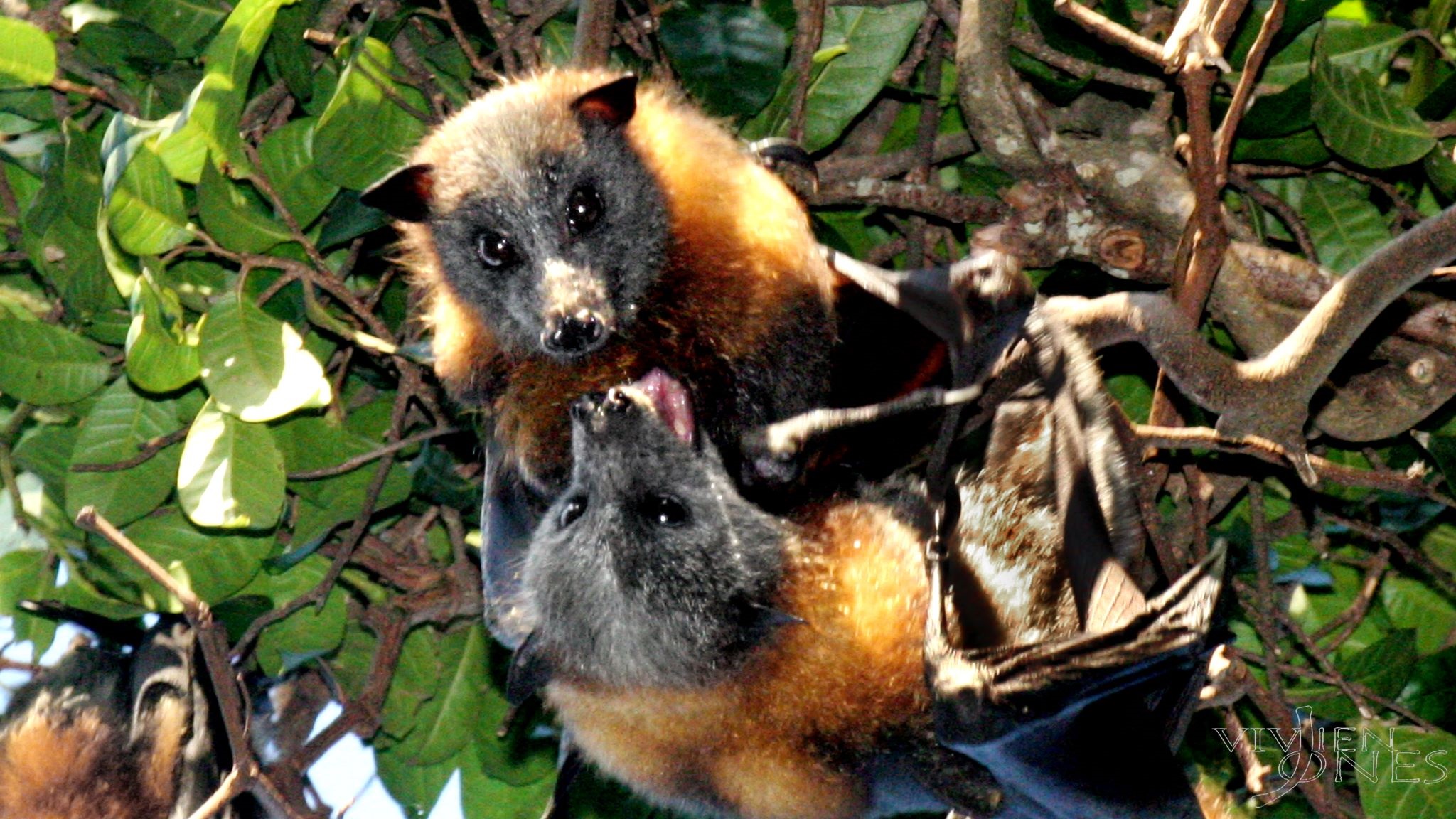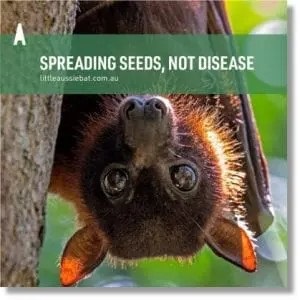Flying-Foxes

The Bellingen Shire is home to several flying-fox camps; the main camp is of national significance and is within walking distance of the Bellingen township at Bellingen Island. These camps are mostly occupied by the grey-headed flying-fox (Pteropus poliocephalus), a state and nationally threatened species, and on occasion by the black flying-fox (Pteropus alecto) and the little red flying-fox (Pteropus scapulatus).
The grey headed flying fox is an umbrella species in Council's Biodiversity Strategy. This means that protecting this species, the many other species that make up the ecological community of its habitat are also protected.
Image: Pair of Grey Headed Flying-Fox

Bellingen Island Flying-Fox Population Increase - March 2024
You might have noticed that over the past couple of weeks, the population of flying-foxes on Bellingen Island has increased dramatically. Not only that, they’ve moved into the trees behind Dowle Street, and they’re very noisy!
What’s going on?
Well, first, we need to understand that the population of flying-foxes in any site is incredibly variable… They move up and down the east coast over a huge range (Bundaberg – Melbourne – Adelaide) depending on what’s flowering and fruiting, and where they’re comfortable. So the population in a camp like Bellingen Island can vary hugely over a short period from zero to 30 or 40 thousand or even more depending on what’s happening in the broader environment. And this movement has changed over the last few years, as climate change has altered weather patterns and hence those flowering and fruiting cycles…
Secondly; March – April is mating season for our Grey-headed and Black flying-foxes. During this couple of months, the flying-fox camps along the east coast are incredibly busy and noisy. The adult males have each marked a territory in the camp; just a small area of a branch or couple of branches, by scent marking with secretions from a gland between their shoulder blades, and vigorously defend this territory against any other male who dares to come near. Any approaching bat is greeted with a short high-pitched scream that basically means “This is MY territory!”
The females choose which males' territory they'll hang in. They're looking for a fit healthy mate - someone big and strong who's likely to give them the best offspring. The boys make a long drawn-out courtship call - it's a bit like a braying donkey, and it’s the male telling everyone – not just the female in front of him, but everyone around – just how big and strong he is (it's also what we call an honest signal - the strongest fittest bats can call louder and longer...).
At night, instead of spending all night out looking for food, the males will fly out for a quick snack, then come back in the camp to defend their territory. This can be as early as 9 or 10 pm, and as the males will scream at any bat that even flies past, this is not a pleasant time for the bat’s human neighbours...
Thankfully, this intense period of all-night noise only goes on for about four weeks.
And lastly, at this time of year it’s getting a bit wetter and cooler – so the bats on Bellingen Island, who basically love sunbaking during the day, move to the more northern side of the roost area where it’s a bit more exposed, so they can get more sun (This is exaggerated this season because we’ve had hot wet conditions over summer so the vegetation on the island has grown explosively – which means it’s dense, but there’s less nice exposed areas for the bats to hang in the sun…)
The end result of all this is that at Bellingen at the moment, we’ve had an influx of flying-foxes to the area (we estimate that there were around 6,000 last month, and around 30,000 now); they’ve moved to the northern edge of the area – including along Dowle Street; and they’re noisy…

Text & Image: Grey Headed Flying-fox courtship - Tim Pearson
Importance of Flying-Foxes
Flying-foxes play a vital role in ecosystem health. Consuming fruit, nectar and blossoms, they can travel up to 100 km in a single night, pollinating and dispersing seeds of native trees. While the Koala's catch cry is "No Tree, No me", flying-foxes can claim "No me, No tree"!
Flying-foxes are protected native animals (like kangaroos and koalas). Their existence is threatened by human activities such as vegetation clearing which removes their food and shelter, illegal killing and entanglement in wire, netting and powerlines. The survival of flying-foxes depends on our ability to live with them, and Council aims to find a balance between managing flying-foxes in urban areas and protecting their future through education and research.

Tips for living near Flying-Foxes
A flying-fox "camp" is a patch of trees that flying-foxes are found in during the day. Living near these camps can sometimes cause noise, smell and odour issues, but there are ways to minimise the disturbance camps can cause. Camps may be temporary - only used while they are close to a food source - or they may be occupied long term.
When disturbed or frightened, flying-foxes will become more vocal. To avoid increasing noise levels from a camp is is best they are admired from a distance.
Issues relating to small, noise, mess and damage to vegetation are usually short lived and can generally be quickly addressed:
- Bring your washing in before sunset and cover with a sheet or shower curtain during the day
- Park your car/boat/caravan under shelter - or use a car cover
- Flying fox droppings can be removed from outdoor surfaces with soap and water. Stains on washing can be removed with a soak with stain remover.
- Avoid disturbing roosts
- net your fruit trees
- If you are impacted by flying-fox odour, close windows and doors on hot humid or low wind days or directly after rain when the smell can be at its worst. Odour has no direct impact on human health.
- Swimming pools can be protected with a pool cover.
- If you collect rainwater for drinking, first-flush diverters that clear contaminants before clean water is collected in the tank should be installed. Inlets and outlets on rainwater tanks should also be screened and the tank covered with a roof structure.
- Flying foxes may cause some people to become distressed and sleep deprived - please seek advice from a health professional if this relates to you.
Bellingen Shire has developed a Camp Management Plan for the Bellingen Island Camp. This has been certified by the Federal Government and adopted by Council. It guides Council in the management of the camp and aims to reduce its impact on neighbours.
Bellingen-Island-Flying-fox-Camp-Management-Plan(PDF, 3MB)
Protecting your backyard fruit
- Flying-foxes do not regard our domestic fruit trees as the first choice for their diet. However, at times they will utilise fruit trees, especially when natural food sources of nectar and pollen are scarce.
- You may need to net your fruit trees to protect them from flying-foxes. possums and birds. There are a wide range of netting options, and some may even help to increase the yield of fruit. Only use netting with a small weave that you cannot poke your finger through to avoid entangling flying-foxes and other wildlife.
- Avoid the use of barbed wire fences near flowering/fruiting plants or dams so that flying-foxes feeding, or drinking don’t become ensnared. If you have existing barbed wire, tie white tags at 5m intervals along the fence so that Flying Foxes can see the wire at night.
Growing plants for foraging flying-foxes
Every year many flying-foxes are injured or killed from eating Cocos palm fruit. It can cause severe dehydration and gut problems and the seeds can choke flying-foxes or get caught behind their teeth, leading to a slow death by starvation. Flying-foxes can also become entangled or damage wing membranes on the tough flower spikes. To avoid these issues, and also minimise noise at night and mess from foraging flying-foxes, remove Cocos palms from your property or cut down the fruits when they are green.
If you don’t mind flying-foxes dropping in for a quick feed, see the list below for native food species for flying-foxes.
Flying-fox food
- Lilly Pilly (Acmena smithii)
- Bangalow Palm (Archontophoenix cunninghamiana)
- Pink Bloodwood (Corymbia intermedia)
- White Mahogany (Eucalyptus acmenoides)
- Grey Box (Eucalyptus moluccana)
- Brush Cherry (Syzygium australe)
- Melaleuca (Melaleuca quinquinervia)
Flying-fox Roost Habitat Restoration Project - Bellingen Island
Council is currently administering a Flying Fox Roost Habitat Restoration Project at Bellingen Island. This eight year project began in 2022 and is funded by the NSW Government & Local Government for NSW.
Over the 8 years the program will run, it will seek to:
- continue restoring existing roost habitat at Bellingen Island
- extend potential habitat to the western end of Bellingen Island to relieve pressure on the small patch of forest currently supporting flying-foxes, and restore the riparian environment at The Point and an area surrounding the Bellingen Wastewater Treatment Plant
- create and maintain buffers between flying-fox roost habitat and urban landholders
- share information with the community about flying fox conservation
- undertake research into whether flying-foxes move to enhanced, restored, and created roost habitat, the environmental factors which influence this and the impact on camp neighbours.
Bellingen_Island_Monitoring_1-year_Summary.pdf(PDF, 8MB)

Flying-foxes and Heat Stress
Heat stress events in flying-foxes can occur when where the temperature exceeds and stays above 38°C, and particularly when temperatures exceed 42°C or when there is a combination of high heat and high humidity. These conditions are most likely to occur in the warmer months of November to February and are expected to increase in frequency due to climate change.
Council is currently developing a Flying Fox Heat Stress Event Procedure in conjunction with WIRES and other agencies for the camps in our Shire.
Australian Bat Liyssavirus (ABLV)
The risk of Australian Bat Lyssavirus (ABLV) exposure is very low; research indicates that less than 1% of free-living bats carry ABVL.
Infection is easily prevented by not handling any bat (even if dead). If disposing of a dead bat, do not directly touch it, wear thick gloves or use a shovel or tongs, then double-bag in thick plastic before disposing.
Pre and post-exposure vaccinations that will prevent ABLV are also available.
You can’t catch ABLV from living near a camp or a fly-out route, or from bat droppings.
No dog or cat has become ill with ABLV, but any mammal that comes into close contact with the virus may be at risk and measures should be taken to prevent pets coming into contact with bats. This may include keeping pets inside when flying-foxes are feeding on fruiting or flowering trees on your property. If you believe your pet has been exposed, wash the area (as with human exposure) and seek immediate veterinary advice. Post-exposure vaccinations are possible if needed.
What should I do if I have been bitten or scratched by a flying-fox?
- Immediately wash (but do not scrub) the wound with soap and water for five minutes. Apply an antiviral antiseptic (e.g. betadine).
- Seek immediate medical attention from your doctor or New South Wales Health (ph. (02) 9391 9000).
- If flying-fox saliva contacts the eyes, nose or mouth, the area should be flushed thoroughly with water and contact your doctor to determine whether post-exposure treatment is required.
- If the bat is dead, call Council to ask them to remove it.
Flying-foxes, horses and Hendra virus
Flying-foxes are a natural host for Hendra virus, which can be transmitted to horses. Infected horses sometimes amplify the virus and can then transmit it to other horses and humans. The virus has never been passed directly from flying-fox to human.
Horses are thought to contract the disease after ingesting food contaminated with flying-fox urine, saliva or birthing fluids. Vaccination and appropriate horse husbandry can protect horses, and subsequently humans, from infection. Further information for horse owners can be found at Department of Primary Industries.
Two dogs have tested positive for Hendra virus, both following close contact with infected horses. There is no evidence that dogs can be infected directly from flying-foxes.

Reporting dead or injured flying-foxes
WIRES (Wildlife Rescue)
1300 094 737
Rescue and rehabilitation of sick, injured or orphaned wildlife
www.wires.org.au/branch/midnorthcoast
Bellingen Vet Hospital
02 6655 1098
To accept of sick, injured or orphaned flying-foxes - remember do not touch flying foxes if you have not ben vaccinated by ABLV
www.bellingenveterinaryhospital.com/
Further information
Living with Grey Headed Flying-foxes
Flying-foxes of NSW
Health and Handling of Flying-Foxes
Heat Stress in Flying Fox Camps
Wildlife Friendly Fencing Project
Grey-headed flying-fox native species diet list
Little Aussie Battlers